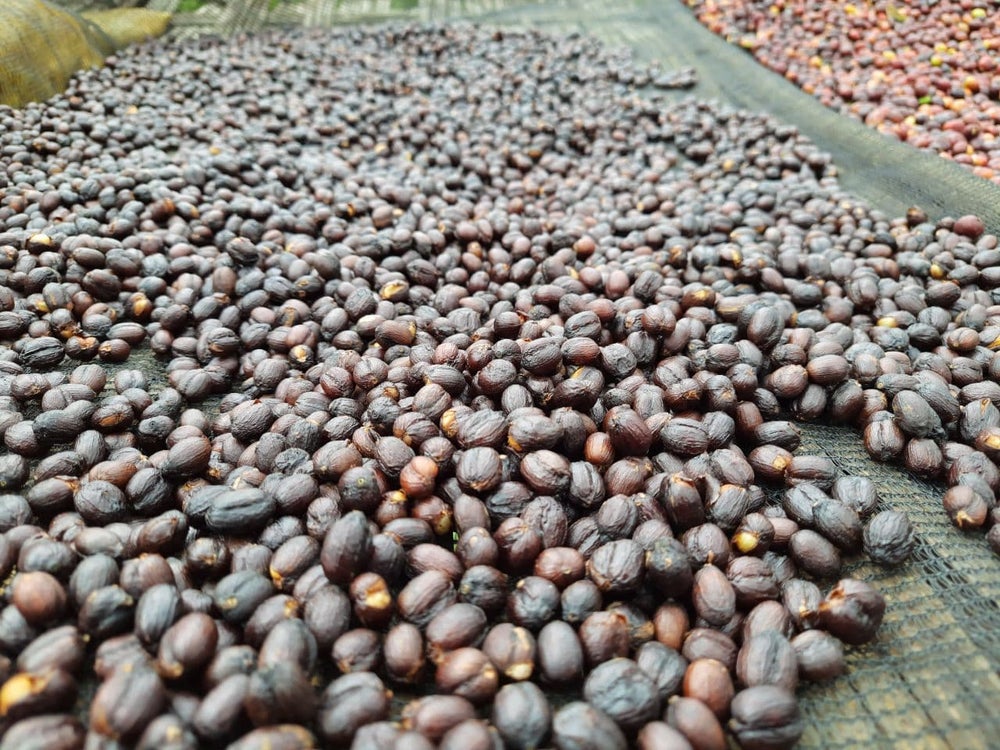About This Coffee
Chelbessa Washing Station, where this coffee was processed, is fairly new to the coffee landscape in Yirgacheffe. Nonetheless, this family-owned and operated washing station is producing exceptional coffees on par with some of the region’s most renowned and established outfits.
Cultivation
Farmers in this region have farmed coffee for generations upon generations. They are true specialists and are committed to using the best chemical-free cultivation methods. These cultivation methods result in an already stand-out product, and Chelbessa makes the most of this by adhering to stringent post-harvest standards.
Harvest & Post-Harvest
This lot is processed using carbonic maceration, a processing technique inspired by winemaking. Like anaerobic fermentation, carbonic maceration typically takes place in a sealed environment. While the method is similar, the main difference between anaerobic and carbonic fermentation is that anaerobic describes a no-oxygen environment and carbonic describes a carbon dioxide-rich environment.
Creating a carbon dioxide-rich environment alters the kinds of microbes that will survive and flourish during fermentation. Different microbial activity will alter the flavor profile and can produce extremely unique and delicious flavors.
Farmers selectively handpick cherry and deliver it to the washing station. At intake, employees hand sort incoming cherry to remove any under- or over-ripes or damaged cherry. Cherry is placed in a container and sealed so that no air can enter. In this sealed environment, fermentation begins. Because the skins of the cherries are left intact, fermentation may take days or weeks. Once fermentation is complete, cherry is removed, washed in clean water and laid on raised beds to dry. Drying coffee is raked regularly to ensure even drying.
About Yirgacheffe
Yirgacheffe is a district in Southern Ethiopia’s Sidamo region. Yirgacheffe is widely recognized as one of coffee’s ‘birth regions.’ Washed coffees coming from this district are so well-known and sought-after that Yirgacheffe is considered its own micro-region.
The majority of coffees grown in Yirgacheffe are local landrace varieties (which are often also called Ethiopian heirloom). Other varieties grown in the region were developed by the Jimma Agricultural Research Centre (JARC). JARC is an important research center for Ethiopia and has done a great deal of work on developing disease-resistant and high-yielding varieties that still demonstrate quality in the profile.
Most farmers in the region farm on fewer than 5 hectares (many counting their coffee farms in terms of trees rather than area). Cultivation methods are traditional for the most part, with coffee being grown as part of an integrated ‘coffee garden,’ intercropped with other food crops.
Coffee in Ethiopia
While Ethiopia is famous as coffee’s birthplace, today it remains a specialty coffee industry darling for its incredible variety of flavors. While full traceability has been difficult in recent history, new regulations have made direct purchasing possible. We’re partnering directly with farmers to help them produce top quality specialty lots that are now completely traceable, adding value for farmers and roasters, alike.
The exceptional quality of Ethiopian coffee is due to a combination of factors. The genetic diversity of coffee varieties means that we find a diversity of flavor, even between (or within) farms with similar growing conditions and processing. In addition to varieties, processing methods also contribute to end quality. The final key ingredients for excellent coffee in Ethiopia are the producing traditions that have created the genetic diversity, processing infrastructure and great coffee we enjoy today.
Most producers in Ethiopia are smallholders, and the majority continue to cultivate coffee using traditional methods. As a result, most coffee is grown with no chemical fertilizer or pesticide use. Coffee is almost entirely cultivated, harvested and dried using manual systems.

